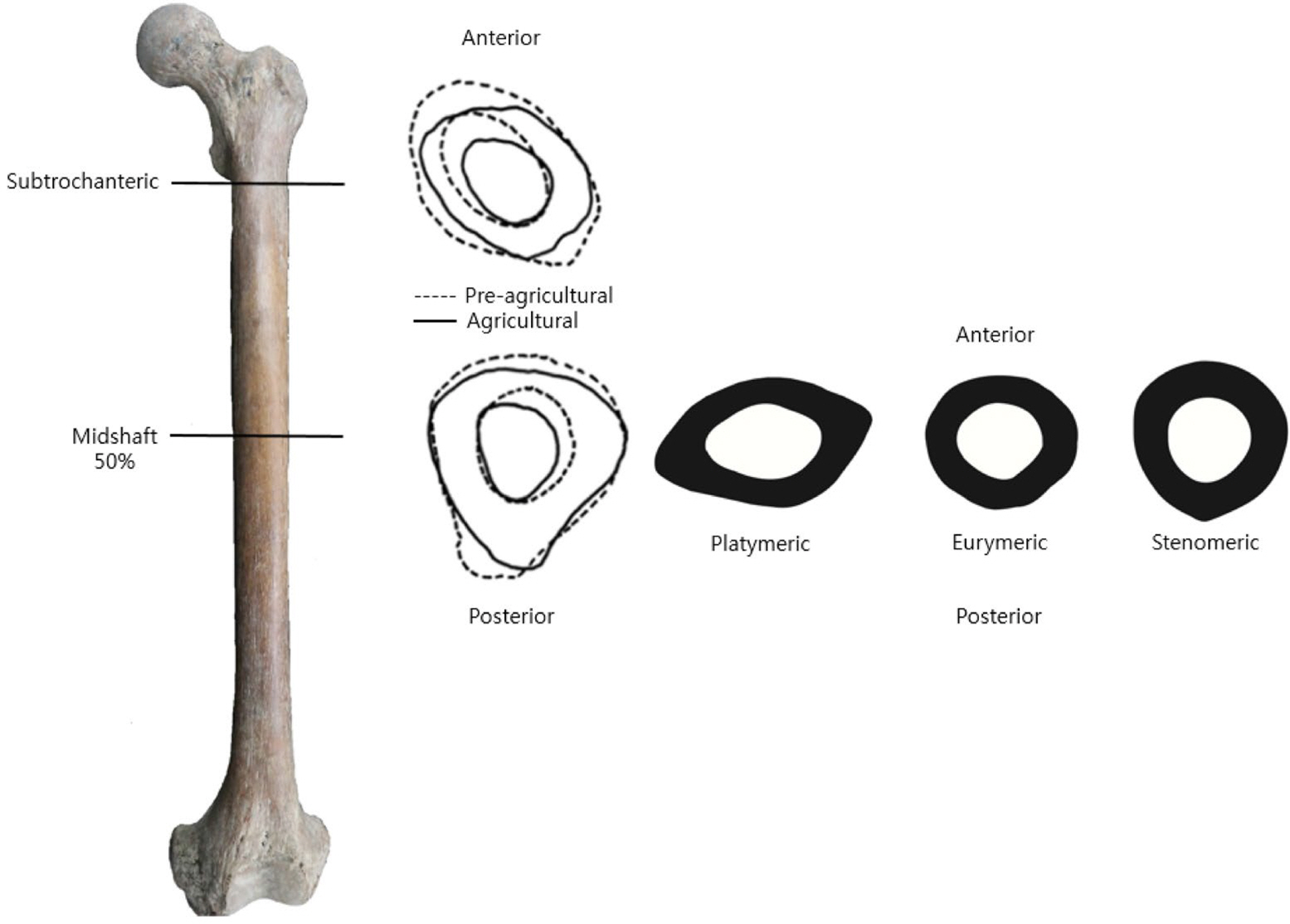Anat Biol Anthropol.
2019 Mar;32(1):23-29. 10.11637/aba.2019.32.1.23.
Biomechanical Analysis of Femoral Diaphyseal Cross-sectional Properties from the Three Kingdoms Period Populations, Korea
- Affiliations
-
- 1Department of History, College of Liberal Arts, Sejong University, Seoul, Korea. redqin@sejong.ac.kr
- 2Department of Anthropology, University at Buffalo, SUNY, New York, USA.
- KMID: 2442781
- DOI: http://doi.org/10.11637/aba.2019.32.1.23
Abstract
- The purpose of this research is to examine and report the biomechanical characteristics of the past populations that lived in different environments during the Three Kingdom Period of ancient Korea. In this research, the cross-sectional size of the femoral subtrochanter region and mid-shaft was measured for the human skeletal remains excavated from the Three Kingdoms Period sites: Imdang and Yean-ri site. The results showed that two populations were grouped into the platymeric category. Moreover, female groups were more platymeric than males. The difference in platymeric index between populations was significant only among female groups with the samples of Imdang site more platymeric than those of Yean-ri site. Meanwhile, pilasteric indexes in two populations were similar level. This study is the first report of the mechanical characteristics in the Three Kingdoms Period population. Yet, for more detailed understanding, it is necessary to investigate more individuals of indicators for biomechanical loading in ancient Korean populations.
Figure
Reference
-
References
1. Ruff CB, Hayes WC. Cross-sectional geometry of Pecos Pueblo femora and tibiae-a biomechanical investigation: 1. Method and general patterns of variation. Am J Phys Anthropol. 1983; 60:359–81.2. Ruff CB. Biomechanical analyses of archaeological human skeletons. Katzenberg MA, Saunders SR, editors. editors.Biolog-ical anthropology of the human skeleton. New York: Wiley;2000. p. 71–102.
Article3. Fung YC. Biomechanics: mechanical Properties of Living Tissues. New York: Springer-Verlag;1993. p. 500–18.4. Vuori I, Heinonen A, Sievanen H, Kannus P, Pasanen M, Oja P. Effects of unilateral strength training and detraining on bone mineral density and content in young women. Calcif Tissue Int. 1994; 55:59–67.5. Püschel TA, Benítez HA. Femoral functional adaptation: a comparison between hunter gatherers and farmers using geometric morphometrics. Int J Morphol. 2014; 32:627–33.
Article6. Lovejoy CO, Trinkaus E. Strength and robusticity of the Ne-anderthal tibia. Am J Phys Anthropol. 1980; 53:465–70.7. Bridges PS, Blitz JH, Solano MC. Changes on long bone diaphyseal strength with horticultural intensification in west-central Illinois. Am J Phys Anthropol. 2000; 112:217–38.8. Woo EJ, Jeong Y, Jung H, Pak S. Biomechanical properties of femoral diaphyseal cross-sectional shape from the Eunpyeong population. J Korean Phys Anthropol. 2014; 27:39–45. Korean.
Article9. Kim S. A study on the social organization of the Yean-ni burial site. Yeungnam Archaeology. 2001; 29:43–70. Korean.10. Seo MS, Lee KS. Genetic analysis of ancient human bones excavated in Sacheon Nuk-do and Gyeongsan Yim-dang-dong, Korea. Conserv Stud. 2004; 25:47–74. Korean.11. Shin JY, Lee J-J. Tracing-status dietary differences in the Silla period through stable isotope palaeodietary reconstruction from Imdang, Gyeongsan. J Korean Archaeol Soc. 2009; 70:84–109. Korean.12. Lee J, Ha D, Pak S, Woo EJ, Lee C, Kim D, et al. The relations of the dead: identifying the relationship of individuals buried at Imdang, Gyeongsan, through the analysis of mitochondrial DNA from human skeletal remains interred in large mounded tombs. J Korean Archaeol Soc. 2008; 68:128–55. Korean.13. Jung S-S, Choi B-I. A study on the average lifespan of the tomb owner from Yimdang site, Gyeongsan and Yeanri stie, Gimhae. Field Archaeol. 2015; 22:27–52. Korean.14. Buikstra JE, Ubelaker DH. Standards for data collection from human skeletal remains. Arkansas Archaeological Survey Research Series No. 44. Fayetteville;. 1994.15. Moore-Jansen PM, Ousley SD, Jantz RL. Data collection procedures for forensic skeletal material. Report of Investigations No. 48. Knoxville: University of Tennessee;1994. p. 79–80.16. Bass WM. Human osteology. Columbia: Missouri Archaeological Society;2005. p. 225.17. Ruff CB, Larsen CS, Hayes WC. Structural changes in the femur with the transition to agriculture on the Georgia coast. Am J Phys Anthropol. 1984; 64:125–36.
Article18. Tallman SD, Winburn AP. Forensic applicability of femur subtrochanteric shape to ancestry assessment in Thai and White American males. J Forensic Sci. 2015; 60:1283–9.
Article19. Wescott DJ. Effect of mobility on femur midshaft external shape and robusticity. Am J Phys Anthropol. 2006; 130:201–13.
Article20. Kimura T, Takahashi H. Mechanical properties of cross section of lower limb long bones in Jomon man. Anthropol Sci. 1982; 90:105–18.
Article21. Wescott DJ. Population variation in femur subtrochanteric shape. J Forensic Sci. 2005; 50:286–93.
Article22. Mcllvaine BK, Schepartz LA. Femoral subtrochanteric shape variation in Albania: implications for use in forensic applications. HOMO-J Comp Hum Biol. 2015; 66:79–89.23. Yeungnam University Museum. 1982, Excavate the Imdang. 2012. p. 43. Korean.
- Full Text Links
- Actions
-
Cited
- CITED
-
- Close
- Share
- Similar articles
-
- Biomechanical Properties of Femoral Diaphyseal Cross-sectional Shape from the Eunpyeong Population
- The Clinical Study for Union Period of Closed Femoral diaphyseal Fractures: Comparsion of Solitary Fractures with Multiple Long Bone Fractures
- Lateral Femoral Bowing and the Location of Atypical Femoral Fractures
- Surgical Treatment in Atypical Diaphyseal Femoral Fracture with Anterior and Lateral Bowing
- A Study of Tibio - Femoral Angles and Metaphyseal - Diaphyseal Angles of the Degenerative Arthritic Knees in Korean



